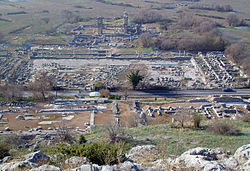The imposing basilica next to the Forum and its gagantic pillars, also known as Basilica B, Philippi (7272724998)
In the VIth century the inhabitants of Philippi embarked on the construction of an imposing basilica on the site of the town's palaestra; the size of the planned building clearly exceeded the needs of the town, thus indicating that Philippi attracted many pilgrims.
There is uncertainty among archaeologists whether the gigantic pillars of the basilica ever supported a dome; in 547 the so-called Justinian plague devastated the countries of the Mediterranean basin and in the early VIIth century an earthquake struck the region of Philippi; these two catastrophic events could have halted the completion of the basilica.
The decoration of the basilica moved away from classic patterns; all representations of human beings and animals were banished and even the acanthus leaves of Corinthian capitals were depicted in an almost symbolic way; this type of "combed" capitals can be observed also at many Byzantine locations in Syria of the same period.
The basilica was at the centre of a complex of buildings which included a chapel reserved to the bishop and a baptistery; the whole complex was built with materials taken from ancient monuments, but the stones were completely reworked in order to eliminate all references to gods, human beings and animals.Relevantní obrázky
Relevantní články
FilippoiFilippoi je sídelní jednotka v Řecku, která se nachází ve východní Makedonii. Je součástí obce Kavala a v roce 2011 zde žilo 11 711 obyvatel. Toto město v současnosti bez většího významu se rozkládá na rozsáhlých ruinách antického města Filippi, které vzniklo při těžbě zlata v pohoří Pangaion. Zdejší starověká archeologická lokalita byla v roce 2016 zapsána na seznam světového kulturního dědictví UNESCO. .. pokračovat ve čtení





